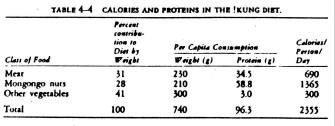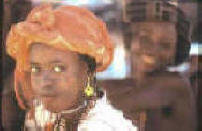1. The
absence of wood placed a severe limitation on the technology that could be
employed by the Inuit. As a result, most of their tools and weapons had to
be made out of bone.
a. true
b. false
2. Which of the following sequences most correctly portrays the concept of Infrastructural Determinism (I→S→SS) within an agricultural village?
a. patrilocal residence → farming → cost of hiring labor
b. motherhood as the supreme virtue → importance of child labor → patrilocal residence
c. importance of child labor to the family → large families → the belief that it is a woman’s duty to have children.
d. patrilineal descent → male oriented household → mostly male labor in farming.
e. male oriented household → elaborate rituals associated with the birth of a son → sexual division of labor in the family.
3. Given that the mode of production (Infrastructure) of any society largely determines the values (Superstructure) that prevail in that society, which of the following groups would most likely produce animal-rights activists?
a. the Dobe Ju/'huansi
b. the Inuit
c. Texas cattle ranchers
d.
post-industrial middle-class suburbanites
4.
Harris and Johnson identify six Modes of Production practiced by human
societies. Based on the principal foods consumed by the Yanomamo and the
means by which they obtain those foods, the Yanomamo would be classified
into which of the following categories of food production?
a. hunting and gathering
b. horticulture
c. pastoralism
d. plow agriculture
e. irrigation agriculture
5. If Indian villagers are expected to marry someone from another village,
which of the following marriage rules is operating?
a.
village endogamy
b.
village exogamy
c.
the levirate
d.
the sororate
e. polyandry
6. Which of
the following statements best summarizes the data in the tables below?


a. While the Ju/'hoansi do not spend much time in pursuit of food, they also do not maintain a nutritionally adequate diet.
b. The Ju/'hoansi maintain a nutritionally adequate diet, but they have to spend most of their time in search of food in order to maintain that diet.
c. The Ju/'hoansi achieve a nutritionally adequate diet on less than half the time the average American spends working.
d. The
Ju/'hoansi work very hard and are still unable to maintain an adequate
diet.
|
7. Which type of descent system is represented in the chart to the right?
a. patrilineal descent b. matrilineal descent c. dual descent d. bilateral decent
8.
Inuit live in large cooperative bands primarily during
|
|
9. From an anthropological perspective, which of the following statements is the LEAST correct regarding the practice of infanticide?
a. The definition of when it is acceptable and appropriate to kill a developing human varies significantly among different human populations, as well as within the same population through time.
b. Europeans and Americans have approached the issue of abortion differently. Unlike in the U.S., abortion in Europe is viewed as a health issue, not as a rights issue.
c. Abortion is morally acceptable because it occurs before birth, whereas infanticide is not because it occurs after a child is born.
d. The practice of infanticide in general and of the greater prevalence of female infanticide in particular can both be accounted for by applying cost/benefit considerations to family planning choices.
e. Late Term Abortions complicate the distinction between abortion and infanticide because they are performed when approximately 80% of the fetus/baby is outside of the womb.
10. Which of the following
statements is most correct regarding Colin Turnbull's and Abruzzi's
explanations of the Mbuti Pygmy behavior in relation to the environment of
the Ituri Forest?
a. Turnbull demonstrates that the Mbuti Pygmies accurately perceive the seasonal changes in their environment and make the appropriate adjustments to those changes.
b. My etic explanation of Mbuti Pygmy behavior in relation to the environment supports their emic explanation of their behavior.
c. Turnbull shows that the Net Hunters have a more realistic view of the environment than the Archers and, therefore, behave more appropriately.
d. Turnbull provides clear data to show that the Ituri Forest is uniform throughout the year in terms of the availability of resources upon which the Mbuti depend.
e.
The distinction between the hunting activities of the Net-Hunters and the
Archers can best be explained by focusing on the cultural values that they
share in common.
11. Which of the following would be examples of classificatory kin categories?
a. father in U.S. kinship
b. father in Yanomamo kinship
c. aunt in U.S. kinship
d. daughter in U.S. kinship
e. b and c
12.
Which of the following likely best represents a
Cultural Materialist
explanation for the small success of family planning programs in Third
World countries is that
a. Most of the people living in these countries believe in conservative religions (such as Buddhism, Islam and Roman Catholicism) which prohibit abortion or contraception.
b. Most of the rural poor of the Third World are too ignorant to know how to practice birth control.
c. The majority of the people in Third World countries favor larger families because of the economic value of children in agricultural societies.
d. The methods of using birth control
techniques have not been adequately explained to the people most in need
of them.
13.
Which of the following is NOT
a characteristic of generalized reciprocity?
a. There is no expectation of an immediate return.
b. There is no systematic calculation of the value of the goods and services exchanged.
c. The goods and services exchanged should be of approximately equal value.
d. It tends to occur among closely related
individuals
14. The shift from an industrial to a post-industrial economy has placed increasing pressure on women to work outside the home. This has increased the cost for women of having children, particularly the negative effect that having children has on both a woman's current earning power and her future job promotion. As a result, there has been a significant decline in the number of children born per female in post-industrial societies, as well as an increase in the number of adult women who have no children.
a. true
b. false
15. Which of the following would be considered a part of Structure?
a. Patrilineal descent among the Yanomamo
b. Dobe Ju/'hoansi knowledge of their environment.
c. Construction of Inuit Igloos
d. Matrilocal residence among the Iroquois
16. If an
anthropologist explains that the increased cost and decreased benefits of
having children has resulted in the decline in fertility in the United
States and other industrial societies during the past 50 years, he or she
has taken a(n) _______ approach to the study of population growth.
a. emic
b. psychological
c. etic
d. biological
e. political
17. Which of
the following statements is most correct?
a. Insects are a poor food source because they provide few nutrients that are of value to humans.
b. Insects are a valuable food resource precisely because they are high in carbohydrates rather than protein.
c. From an ecological point of view, the fact that the Yanomamo eat insects suggests that there are few alternative sources of protein available to them which require less labor to exploit.
d. While the
Yanomamo obtain iron, calcium and other nutrients from insects, they rely
primarily on plantains for their protein.
18.
Which of the following statements is most correct regarding the practice
of female infanticide among the Inuit?
a. It is usually the males, rather than the females, who prefer to kill female infants.
b. While females may agree to kill infants, the death of older children is largely caused by males, because mothers who have raised daughters are likely to have developed emotional bonds with them and are, therefore, less likely to kill them.
c. Among the Inuit (Eskimo), female infants are likely to be killed because, owing to the high mortality of males and the fact that almost all food production is done by men, a family would likely find itself with adult daughters that: (1) cannot be married off, (2) do not increase the wealth or prosperity of the family and (3) must be support on the families limited resources.
d. Female infanticide is more likely to
occur among the Inuit when the cost/benefit ratio of raising girls is
higher than that for boys.
19. Which of
the following statements does NOT apply to the Marshall's ethnography of
the Ju/'hoansi, as presented in the film “The Hunters,” which led to their
view of the Ju/'hoansi as maintaining a marginal subsistence?
a. The Marshalls focused only on large game hunting which, according to Richard Lee, represents only a small fraction of the total food consumed by the Ju/'hoansi.
b. The Marshall's focused on only one group of hunters and ignored the fact that other hunters would also be providing meat for the band.
c. The Marshall's collected their data during the month of July, which is in the middle of the dry season. Their data, therefore, misrepresents Ju/'hoansi diet.
d. Their film does not focus on the vegetables gathered by women, who provide the majority of the food that the Ju/'hoansi consume.
e.
In calculating the Ju/'hoansi's hunting return, the Marshalls mistakenly
calculated that the 13-day giraffe-hunting expedition resulted in only 9
days worth of meat, because while only 4 men hunted for the 13 days, all
the members of the band were fed for 9 days.
20. Which of
the following examples best illustrates the notion that people who utilize
animals as productive
resources rather than as
consumable commodities
are not likely to eat those animals?
a. farmers in India who don't kill their cows for food
b. middle-class Americans who eat beef
c. Shoshone Indians (called the “Digger Indians” by early explorers) of the Great Basin who ate horses when they found them.
d. Plains Indian bison hunters who didn't eat their horses
e. a &
d.
21. From an
anthropological perspective, the lower social status of women relative to
men among the Inuit, Yanomamo and Plains Indians compared to the Pygmies
and the Ju/'hoansi is based on
a. the greater physical strength of men.
b. the fear of women regarding male violence
c. the greater role that men play in the production and distribution of resources critical to these groups' survival.
d. The
greater intelligence of men.
22.
Kinship and residence among the Yanomamo are
a. patrilineal and patrilocal
b. matrilineal and matrilocal
c. bilateral and neolocal
d. ambilineal and neolocal

